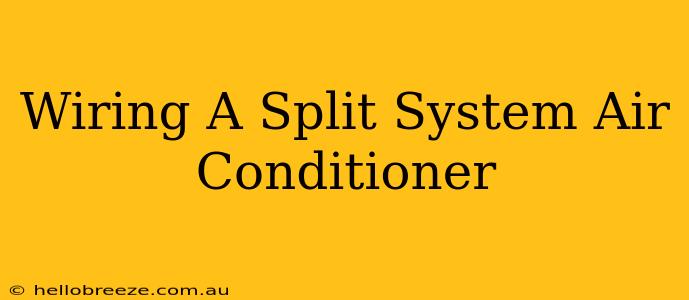Installing a split system air conditioner can significantly improve your home's comfort, but the wiring process requires careful attention to detail and adherence to safety regulations. This comprehensive guide will walk you through the essential steps, helping you understand the intricacies of split system AC wiring. Remember: If you're uncomfortable working with electricity, it's crucial to hire a qualified HVAC technician. Incorrect wiring can lead to serious damage or injury.
Understanding Split System AC Components
Before diving into the wiring process, let's familiarize ourselves with the key components of a split system air conditioner:
- Outdoor Unit (Condenser): This unit houses the compressor, condenser coil, and other components responsible for releasing heat outside.
- Indoor Unit (Evaporator): Located inside your home, this unit contains the evaporator coil, blower fan, and air filter. It cools the air and circulates it throughout your space.
- Interconnecting Lines: These lines, typically copper tubing and electrical wiring, connect the outdoor and indoor units. They carry refrigerant and electrical signals.
- Electrical Panel: The main power supply for your air conditioner connects to your home's electrical panel.
Essential Tools for the Job
Before starting, gather the necessary tools:
- Voltage Tester: Crucial for safety, ensuring power is off before working on any electrical components.
- Wire Strippers and Cutters: For preparing the ends of electrical wires.
- Crimping Tool: To secure wire connections securely.
- Screwdrivers (Phillips and Flathead): For various connections and fasteners.
- Level: To ensure proper installation of the units.
- Refrigerant Manifold Gauge Set: For charging the system with refrigerant (requires specialized knowledge and should be handled by professionals).
- Electrical Tape: For insulating connections.
- Appropriate Wiring: Use wiring that matches the specifications provided in your unit's manual.
Step-by-Step Wiring Guide
Disclaimer: This guide provides a general overview. Always refer to your specific air conditioner's installation manual for detailed instructions and safety precautions. Incorrect wiring can lead to serious consequences.
Step 1: Safety First!
- Turn off the power: Completely disconnect the power supply to both the indoor and outdoor units at the breaker box. Double-check with a voltage tester to confirm the power is off.
Step 2: Connecting the Electrical Wiring
- Identify wires: Carefully identify the wires according to your unit's wiring diagram. Common wires include hot (typically black or red), neutral (white), and ground (green or bare copper).
- Connect wires: Connect the wires from the indoor unit to the outdoor unit, following the specific color codes in your manual. Secure connections with wire nuts or connectors, ensuring a tight fit.
- Grounding: Connect the ground wire appropriately to the ground terminal on both units and the electrical panel, ensuring a safe path for any electrical leakage.
Step 3: Securing the Wiring
- Protect wiring: Securely fasten the wiring to avoid damage or strain. Use cable ties or other appropriate methods.
- Insulate connections: Use electrical tape to insulate all wire connections thoroughly, preventing short circuits.
Step 4: Connecting to the Power Supply
- Connect to the breaker: Connect the main power wire to the appropriate breaker in your home's electrical panel, making sure the breaker is correctly sized for the air conditioner's amperage requirements.
Step 5: Refrigerant Lines (Professional Assistance Required)
This step is highly complex and dangerous and should only be handled by a qualified and licensed HVAC technician. Improper handling of refrigerant can cause serious injury or environmental damage. This includes:
- Evacuating the lines: Removing air and moisture from the refrigerant lines.
- Charging the system: Adding the correct amount of refrigerant.
- Testing for leaks: Checking for leaks in the refrigerant lines.
Step 6: Testing and Final Checks
- Turn on the power: After completing the wiring and refrigerant connections, turn the power back on at the breaker box.
- Test functionality: Check for proper operation of both indoor and outdoor units. Ensure that the unit cools effectively and no unusual noises are present.
Maintaining Your Split System Air Conditioner
Regular maintenance is essential for the optimal performance and longevity of your split system air conditioner:
- Clean or replace air filters regularly: Dirty filters restrict airflow and reduce efficiency.
- Inspect coils for dirt and debris: Clean coils as needed to ensure proper heat exchange.
- Schedule professional maintenance: Annual inspections and service by a qualified technician help identify potential problems early.
By following this guide carefully and prioritizing safety, you can successfully wire your split system air conditioner. However, remember that professional assistance is highly recommended, especially for tasks involving refrigerant handling and complex electrical work. Safety should always be your top priority.

